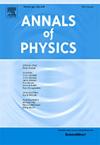Quantum gravitational corrections to a Kerr black hole using Topos theory
IF 3
3区 物理与天体物理
Q2 PHYSICS, MULTIDISCIPLINARY
引用次数: 0
Abstract
We examine non-perturbative quantum gravitational corrections to a Kerr black hole using Topos theory. Black hole thermodynamics is modeled using sheaves, and these corrections are represented as additional morphisms on these sheaves. These corrections are thus expressed as intrinsic structural modifications modeled by these new morphisms, allowing both the original and quantum gravitationally corrected structures to exist within the same Topos. We also construct a functor between thermodynamics and information theory by using the Parikh–Wilczek formalism to represent the probability density of emitted particles as sheaves. Then, using the Kullback–Leibler divergence as another functor, we measure deviations of the quantum gravitationally corrected sheaves from the original sheaves. To obtain information about the modifications produced by quantum gravity, we construct an additional functor representing Fisher information. Topos theory provides a formalism that allowing us to study properties of the system in classical spacetime as well as cases where the classical spacetime breaks down near the Planck scale. This formulation reveals a novel information paradox in the ultraviolet regime of quantum gravity, where not only does information about particle states become inaccessible, but even information about the quantum gravitational modifications themselves becomes computationally unobtainable.
利用Topos理论对克尔黑洞进行量子引力修正
我们用Topos理论检验克尔黑洞的非微扰量子引力修正。黑洞热力学是用“束”来建模的,这些修正被表示为“束”上的附加态射。因此,这些修正被表达为由这些新态射建模的内在结构修正,允许原始和量子引力修正的结构存在于相同的Topos中。我们还利用Parikh-Wilczek的形式构造了一个介于热力学和信息论之间的函子,将发射粒子的概率密度表示为束状。然后,使用Kullback-Leibler散度作为另一个函子,我们测量了量子引力修正的束与原始束的偏差。为了获得关于量子引力产生的修正的信息,我们构造了一个附加的函子来表示Fisher信息。拓扑理论提供了一种形式,使我们能够研究系统在经典时空中的性质,以及经典时空在普朗克尺度附近崩溃的情况。这个公式揭示了量子引力紫外区中一个新的信息悖论,不仅关于粒子状态的信息变得不可访问,甚至关于量子引力修正本身的信息也变得无法计算。
本文章由计算机程序翻译,如有差异,请以英文原文为准。
求助全文
约1分钟内获得全文
求助全文
来源期刊

Annals of Physics
物理-物理:综合
CiteScore
5.30
自引率
3.30%
发文量
211
审稿时长
47 days
期刊介绍:
Annals of Physics presents original work in all areas of basic theoretic physics research. Ideas are developed and fully explored, and thorough treatment is given to first principles and ultimate applications. Annals of Physics emphasizes clarity and intelligibility in the articles it publishes, thus making them as accessible as possible. Readers familiar with recent developments in the field are provided with sufficient detail and background to follow the arguments and understand their significance.
The Editors of the journal cover all fields of theoretical physics. Articles published in the journal are typically longer than 20 pages.
 求助内容:
求助内容: 应助结果提醒方式:
应助结果提醒方式:


